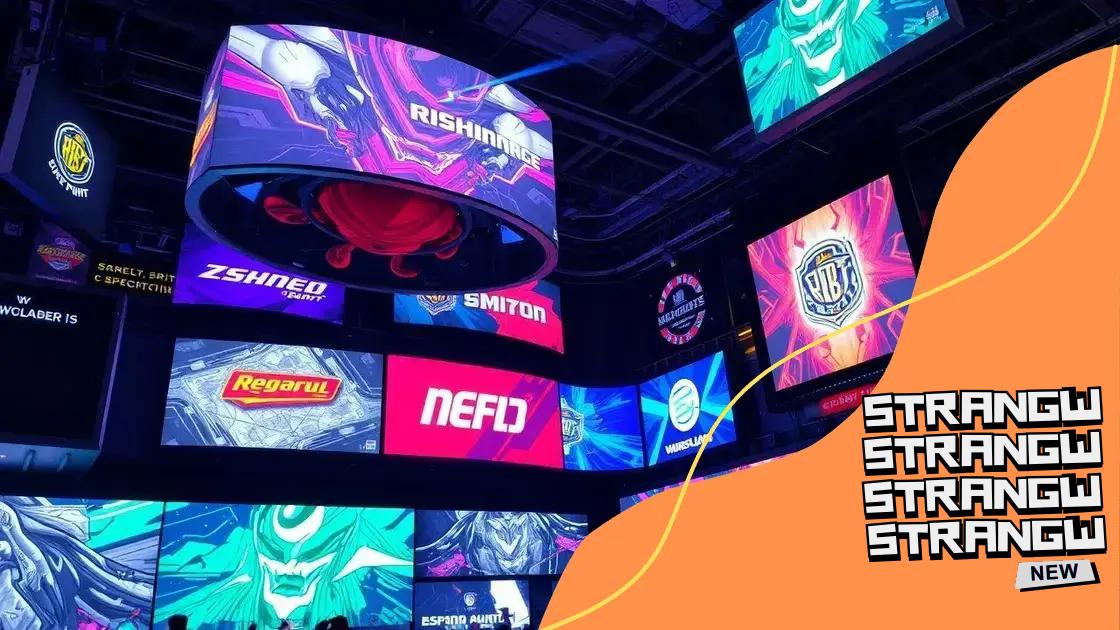How e-sports are influencing mainstream media content

How e-sports are influencing mainstream media content includes increased television coverage, collaborations with influencers, and innovative advertising strategies, driving engagement and attracting broader audiences.
How e-sports are influencing mainstream media content is a topic gaining traction among fans and industry insiders alike. The intersection of gaming and media reshapes entertainment as we know it. This article explores the significant trends driving these changes.
The rise of e-sports in popular culture
The rise of e-sports in popular culture has been remarkable over the past decade. Once seen as a niche hobby, competitive gaming has transformed into a mainstream phenomenon. Millions of viewers tune in to watch their favorite players compete, making e-sports a cultural touchstone.
Growth of Audience and Community
The audience for e-sports has grown exponentially. Events like the The International and League of Legends World Championship attract massive live audiences and even larger online viewership. This community connects through streaming platforms like Twitch and YouTube, creating a vibrant ecosystem for fans and players alike.
- Increasing popularity of live broadcasts
- A diverse range of games appealing to various audiences
- The emergence of fan merchandise and culture
As e-sports continue to grow, players are becoming public figures. Many gamers now have large social media followings, influencing trends both in and out of the gaming world. Their personalities draw fans who are invested not just in the games, but in the lives of their favorite players.
Impact on Mainstream Media
Media outlets have begun to recognize the significance of e-sports, integrating it into broader entertainment discussions. Major television networks are airing e-sports competitions, while traditional sports channels feature coverage of gaming events. This exposure has helped to legitimize e-sports as a serious competitive field.
- Increased sponsorships from major brands
- Collaboration between e-sports teams and traditional sports franchises
- Documentaries and features highlighting the lives of gamers
Furthermore, e-sports are influencing other forms of media, such as films, series, and even music. These collaborations reflect how deep gaming culture has penetrated traditional entertainment, indicating that the rise of e-sports is more than just a trend—it’s a cultural shift.
How e-sports are changing viewer engagement
How e-sports are changing viewer engagement is a vital topic in the evolving landscape of entertainment. The shift from traditional sports viewing to the dynamic world of e-sports has created a new era of interaction between viewers and content.
Interactivity and Community
One of the significant changes is the level of interactivity that e-sports offers. Viewers can engage directly with streams through chats, polls, and live comments. This direct interaction fosters a sense of community, making fans feel like they are part of the action. Gamers and fans often share their experiences on platforms like Twitch, where they can cheer for their favorite teams in real-time.
- Live chats enhance viewer experience
- Community events create bonds among fans
- Viewers can interact with players via social media
Moreover, many platforms allow viewers to influence gameplay through votes or by purchasing in-game items that can affect a match. This level of engagement keeps the audience invested, turning passive viewers into active participants.
Content Variety and Accessibility
Another way e-sports are changing viewer engagement is through the variety of content available. From highlights and tutorials to live matches and behind-the-scenes footage, fans have a plethora of options at their fingertips. This diversity caters to different interests, allowing viewers to choose what they want to watch and when they want to watch it.
- Diverse content keeps audiences entertained
- Accessible formats attract a wider demographic
- Streaming platforms offer content on demand
Furthermore, accessibility has improved with mobile streaming and platform integrations. Fans can now watch matches on-the-go, further increasing viewership and engagement. This flexibility allows e-sports to reach audiences who may have previously been unable to engage due to traditional viewing restrictions.
The impact of e-sports on advertising strategies

The impact of e-sports on advertising strategies is significant and continues to grow. As viewership increases, brands are finding innovative ways to connect with audiences that are highly engaged and passionate. This presents a unique challenge and opportunity for advertisers.
Targeting a Young Audience
One major shift in advertising is the focus on a younger demographic. E-sports primarily attract millennials and Gen Z, making it essential for brands to tailor their marketing strategies to resonate with these audiences. Advertisers are creating campaigns that reflect the interests and lifestyles of gamers, incorporating elements that engage this pivotal age group.
- Using relatable influencers to promote products
- Incorporating gaming culture into traditional marketing
- Utilizing humor and creative storytelling in ads
Moreover, brands are leveraging the authenticity of e-sports influencers. By partnering with established gamers, companies gain credibility and reach a dedicated fan base more effectively than traditional advertising methods.
Innovative Advertising Formats
Another major factor in the impact of e-sports on advertising is the format and placement of ads. Instead of traditional commercials, brands are integrating ads directly into the gaming experience. This can include product placements within games, sponsored streams, or branded in-game events. These methods create seamless interactions that do not disrupt the viewer experience.
- Integrating ads into game narratives
- Offering exclusive content during live streams
- Hosting branded tournaments to increase visibility
Additionally, interactive advertising is becoming more popular. Viewers can engage with ads through polls, quizzes, or offers that require participation. This level of interaction keeps the audience interested and can lead to higher conversion rates for brands.
E-sports and traditional media collaboration
E-sports and traditional media collaboration is transforming how audiences consume entertainment. As e-sports gain popularity, traditional media outlets are exploring new partnerships to connect with the gaming community.
Television and Streaming Partnerships
One key area of collaboration is between television networks and e-sports leagues. Major networks are starting to broadcast live events, bringing competitive gaming into millions of homes. This mainstream exposure helps elevate the status of e-sports and attract new fans.
- TV channels offering dedicated e-sports programming
- Streaming platforms hosting exclusive tournaments
- Collaborative promotions for events
Moreover, these partnerships benefit both parties. Traditional media gain fresh content, while e-sports leagues reach wider audiences. This synergy helps legitimize e-sports as a serious sport in the eyes of advertisers.
Innovative Content Creation
Brands and media companies are also teaming up to create unique content around e-sports. Documentaries, interviews, and behind-the-scenes footage provide insights into gamers’ lives and the industry. This type of content appeals to both hardcore fans and casual viewers.
- Feature films about popular gamers
- Documentaries highlighting major tournaments
- Interviews with industry leaders
Furthermore, e-sports events often include interactive elements that traditional media can exploit. For example, live polls and viewer participation boost engagement during broadcasts. This innovative approach brings a fresh experience to viewers, making them feel like part of the action.
Future trends in e-sports and media content
Future trends in e-sports and media content are shaping the entertainment landscape. As technology advances, the way we engage with e-sports will evolve, creating new opportunities for fans and creators alike.
Increased Virtual Reality Integration
One exciting trend involves the rise of virtual reality (VR) in e-sports. As VR technology becomes more accessible, we can expect immersive experiences where players and viewers feel part of the game. This fresh perspective enhances engagement and allows fans to experience matches as if they were on-site.
- VR tournaments bringing fans closer to the action
- Interactive games that involve viewer participation
- Enhanced spectator experiences in VR environments
As VR technology continues to develop, we may see hybrids of real and virtual worlds, changing how e-sports competitions are presented.
Greater Emphasis on Content Diversity
Another trending direction is the focus on diverse content formats. Traditional live broadcasts will continue to coexist with unique formats such as reality shows following gamers’ lives, esports documentaries, and short-form content on social media platforms. This variety caters to different audience preferences, increasing overall engagement.
- Shows delving into players’ backstories
- Short clips on platforms like TikTok and Instagram
- Live Q&A sessions and interactive content
As content expands, companies will experiment with new storytelling techniques, offering fans different ways to connect with their favorite games and players.
Increased Sponsorship and Investment
Finally, the future of e-sports is likely to see increased sponsorship and investment from brands seeking to tap into this growing market. As more companies recognize the potential of e-sports, exclusive partnerships and collaborations will become more common. Brands are already making significant investments, which enhances the overall production quality of events.
- Smart collaborations with lifestyle brands
- Enhanced promotional campaigns during events
- Increased advertising revenue from live streams
This influx of support will help elevate e-sports to new heights while attracting a larger audience base.
FAQ – Frequently Asked Questions about E-sports and Media Content
How are e-sports impacting traditional media?
E-sports are becoming more mainstream as traditional media outlets begin to broadcast live tournaments and create dedicated programming, attracting new audiences.
What role does virtual reality play in the future of e-sports?
Virtual reality is set to enhance the gaming experience by providing immersive interactions, allowing fans to feel like they are part of the action.
How are brands engaging with e-sports audiences?
Brands are leveraging partnerships with e-sports influencers and integrating their products into games and broadcasts to connect with a younger demographic.
What types of content can we expect in the future?
We will see a greater emphasis on varied content formats, including behind-the-scenes videos, reality shows about gamers, and interactive experiences that enhance fan engagement.





